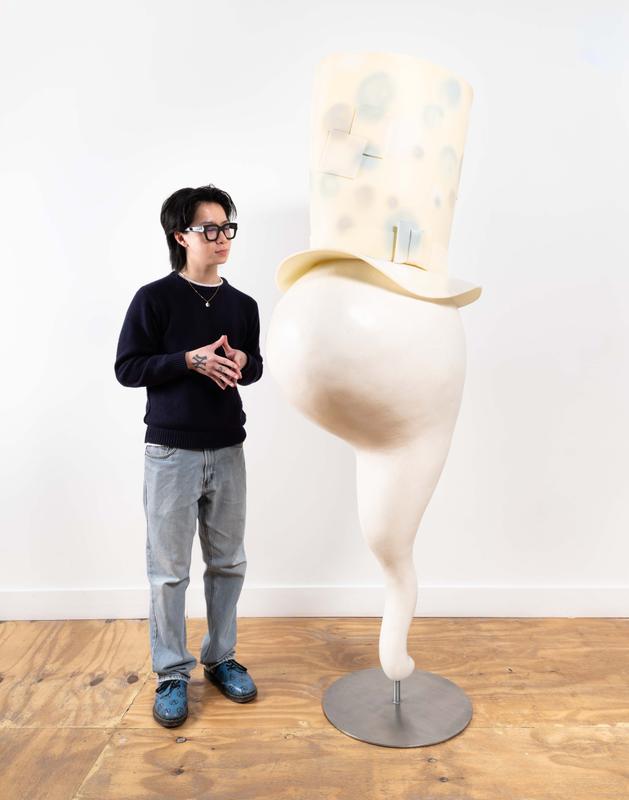
January 20 - March 9, 2024
Kapp Kapp is proud to line you up in Queues, the twins’ second solo exhibition with Louis Osmosis (b. 1996). As the third solo show on the New Yorker’s home turf, Queues recognizes its timing is, fundamentally, comedic. But instead of establishing or breaking a pattern, it mimics the pattern––Osmosis presents a series of sculptures and installations which takes up the very conceit of their lineage for the artist and his contemporaries.
Pairs permeate the show, but as Osmosis readied Queues, the giant sperm––Big Mascot (Ragamuffin)––anchored his preparation, alert and ready for its cue. Shot from the testicular laboratory of the studio, Big Mascot and his six prodigées greet the audience (real fans remember Companion [Hachikō]) as if to plunge us into an unsteady present. The unmoored sperm, characterized and serialized, is a cell defined between the thrust of its past and its potentials. Aren’t we all.
Queues is kunst x hypebeast, and I don’t mean the late/great Pope.L dragging himself across a FW22 ‘Supreme’ t-shirt. For his second show with Kapp Kapp, Osmosis choreographs us through sculptures which iterate, iterate, iterate. David Graeber tells us that the self-actualization of bureaucracy “insists we live in a timeless present…that we simply create the world around us through the power of the will.”1 Queues plops Graeber’s sentiment into the gallery; what might the lineage of these anachronistic objects be amidst the optics of bureaucracy? Can time be kept in these sculptures? Not just the moment they drop and the re-sell bots pounce, but a ‘deadass’ look at the hyper-artisanal that finds definition between its precursors, its line-up, and its fate as an object of flat repetition.
The trio Silver’s Foreclosure, Grey’s Foreclosure, and Red’s Foreclosure avalanche interior logic, where each color is defined through its interface: an NPC gray, Ferrari red, or retrofuturist chrome. The triplet’s sleek execution follows through the many materials in Osmosis’ show, where the artist has carefully applied his hand towards an outcome of anonymity. Not exactly á la mass production, but as an object off the factory line which hopes to emulate a belabored artisanal good; the mechanical print and handmade seek to become one another.
Be it a slough of art history lectures or two solo shows of his own, Osmosis shepherds history. The duo Smokin’ Tiki and Chair with Pipe face these themes with a slick poeticism and frankness. In the former, affection for the sleekness of bureaucracy coalesce into a deadbeat parent and in the latter case, Osmosis figures his sculpture an infantile and obstinate descendant of Robert Gober’s 1994-1995 assemblage of the same title. The work itself a configuration of René Magritte, Osmosis also calls on artists like Eva Hesse or Mona Hatoum who weaponize the functionality of the domestic. This is to say, he is playing on the historicization of lineage on multiple scales and timelines. Even more so with Content House, for Los Angeles and Content House, for New York, a duet of post-minimalist production and reinterpretation hungry for clout and virality.
Incubator and Score, for Ellipsis & Roundtable begin, end, and bleed throughout Queues to physicalize dead time. These interlocked partners conduct a theater of infrastructure; a two way mirror, pseudo-staged storage space, and ringing tone extend Osmosis’ thinking on his lineage to his peers at Kapp Kapp. The digital keyboard, strained beneath the murmur of AM radio, regenerates the initial strike through manufactured looping. Interpolating a 2013 Pope.L work, Score, for Ellipsis & Roundtable figures its inspiration’s rubber balloons in Mylar. A material animated for an occasion and eternally non-degradable, these floating tributes will sink into playability over time. It’s slapstick in its disconnection between incitement and reaction, resulting in an incessant non-moment. Incubator, the cumulative punch of Queues, asks “what’s next?” among the spoils of what has been.
1 David Graeber, The Utopia of Rules: On Technology, Stupidity, and the Secret Joys of Bureaucracy (Brooklyn: Melville House, 2016), 36.
Text by Olivia Rodrigues.
Olivia Rodrigues is a curator and writer based in Brooklyn, New York. She holds a Masters in Curatorial Studies from Bard College and centers her research around interdisciplinary artworks that touch on performance, labor, and joke-making.